The melodious echo of a Shankh (conch shell) is deeply rooted in Indian culture, not just for its spiritual significance but also for its impact on home energy and Vastu. It is believed to be the abode of Lord Vishnu, and its sound is said to purify the surroundings, usher in positive energy, and ward off negativity. But here’s the catch — not all types of shankh are ideal for home use. The type, placement, and even direction matter immensely, especially if you’re concerned with Vastu compliance and spiritual harmony.
In this blog, we dive deep into the types of shankh with names, their benefits, the ideal position of shankh in the pooja room, which shankh is not good for home, and much more. Whether you’re an avid believer or a curious learner, this blog will answer all your questions and even introduce rare types of shankh you’ve probably never heard of.
What is a Shankh, and what is Its Historical Significance?
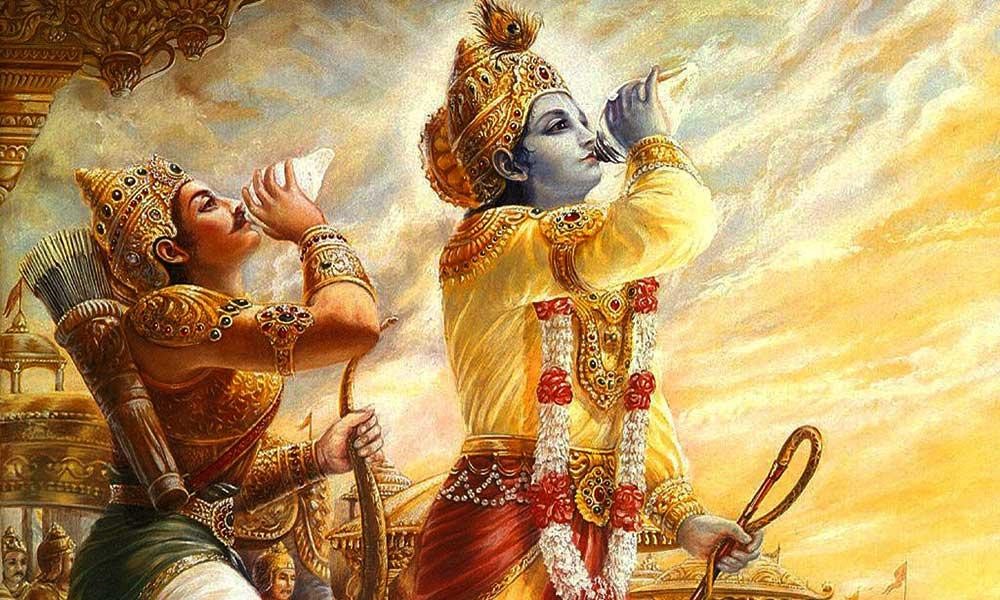
The word Shankh originates from the Sanskrit word Shankha, which means a conch shell. It is considered sacred and is used during religious ceremonies and rituals in Hinduism. Mythologically, it is associated with Lord Vishnu and is said to have emerged from the churning of the ocean (Samudra Manthan).
Over centuries, the Shankh has symbolized prosperity, purity, and divinity. The act of blowing a conch is said to awaken dormant energies and fill the environment with positive vibrations.
Types of Shankh in Hinduism – A Complete Overview
Let’s begin with a detailed overview of all types of shankh, along with their names and significance.
Dakshinavarti Shankh (Right-Handed Conch)

- Spirals to the right
- Associated with Goddess Lakshmi
- Signifies wealth and prosperity
- Ideal for keeping in pooja room
- Not generally used for blowing
Vamavarti Shankh (Left-Handed Conch)

- Spirals to the left
- Commonly used for blowing during rituals
- Associated with Lord Vishnu
- Its sound is said to purify the surroundings
Ganesha Shankh
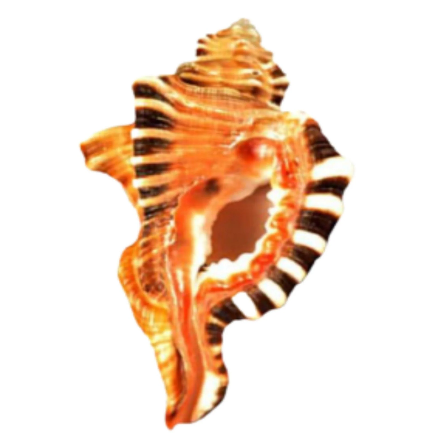
- Features an embossed figure of Lord Ganesha
- Known to remove obstacles
- Best placed in the pooja room or northeast direction
Kauri Shankh
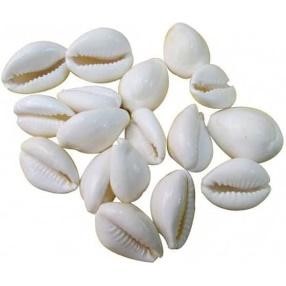
- A smaller and smoother conch
- Brings prosperity and financial stability
- Often kept in cash boxes or money drawers
Gaumukhi Shankh

- Mouth resembles a cow’s face
- Considered extremely auspicious
- Brings peace and harmony to the household
Heera Shankh (Diamond Conch)
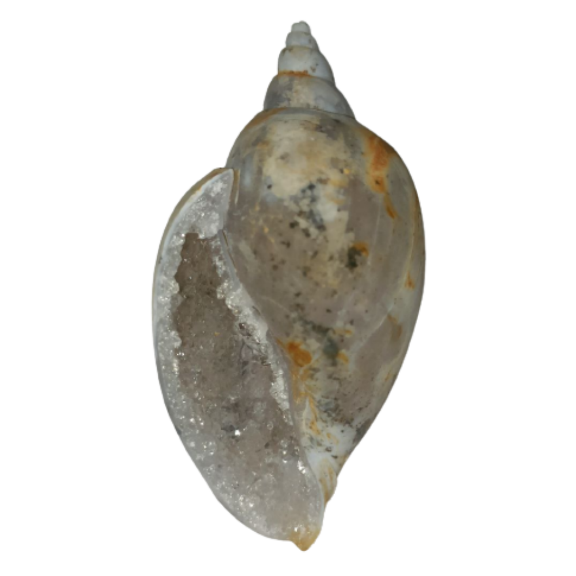
- Extremely rare and valuable
- Known to attract immense wealth and positive energy
- A classic example when referring to rare types of shankh
Moti Shankh (Pearl Conch)
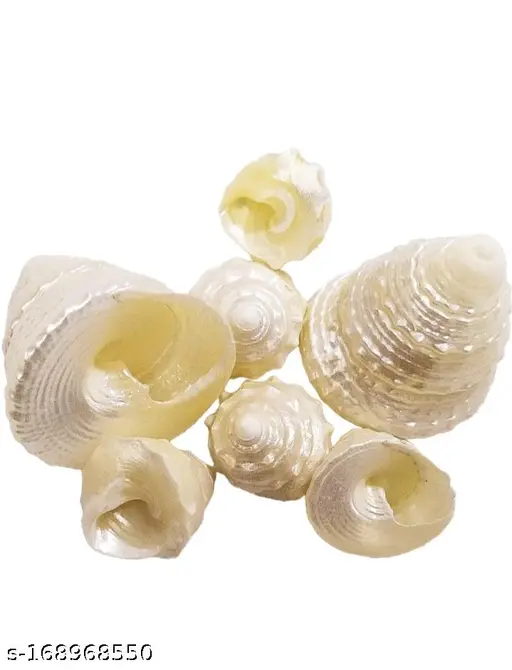
- White and shiny like a pearl
- Enhances calmness, clarity, and peace
- Useful in meditative practices
Pro Tip: When exploring types of shankh with images, make sure to cross-reference with authentic sellers to avoid buying replicas.
Types of Blowing Shankh – For Ritual Use
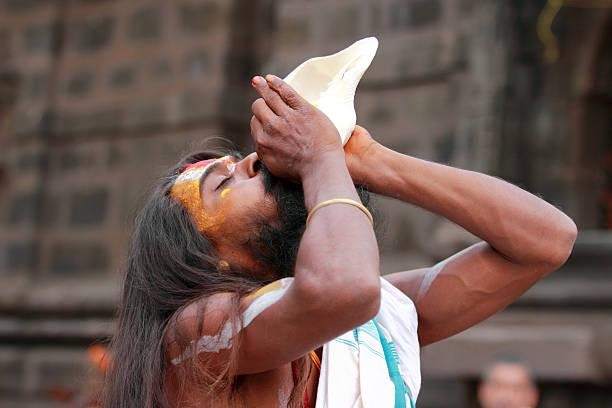
Blowing shankhs are primarily Vamavarti, but others like Panchajanya (Lord Vishnu’s personal shankh) are also crafted for ceremonial use.
Ideal Types of Blowing Shankh:
- Vamavarti Shankh
- Gomukhi Shankh
- Panchajanya Replica Shankh
These are used in temples and homes to mark the start of prayers or auspicious activities.
Benefits of Keeping Shankh at Home

Let’s understand the benefits of keeping shankh at home from a Vastu and spiritual perspective:
- Purifies the Energy: The sound emitted when blown dispels negative energies
- Invites Wealth: Especially the Dakshinavarti Shankh draws financial abundance
- Improves Focus: Its vibrations enhance meditative states
- Health Benefits: Traditional beliefs suggest it aids in respiratory health
- Creates Positive Aura: Helps maintain harmony and peace at home
Is keeping Shankh at Home Good or Bad?
This is one of the most asked questions: Is keeping shankh at home good or bad?
The answer depends on:
- The type of Shankh (right type = good, wrong one = bad)
- Placement as per Vastu
- Whether it’s used or unused (never bring used temple shankhs)
- Whether it’s blown regularly or left idle
So yes, keeping a shankh at home is beneficial, but only when done the right way.
Which Shankh is Not Good for the Home?
- Damaged or cracked Shankh: Considered inauspicious
- Shankh used in Cremation Ceremonies: Brings negative energy
- Improperly Sourced or Duplicate Dakshinavarti Shankh: This can cause more harm than good
- Black-Colored Shankh: Generally avoided in homes
So if you’re wondering which shankh is not good for home, ensure you don’t pick any of the above.
Position of Shankh in Pooja Room – What’s Ideal?
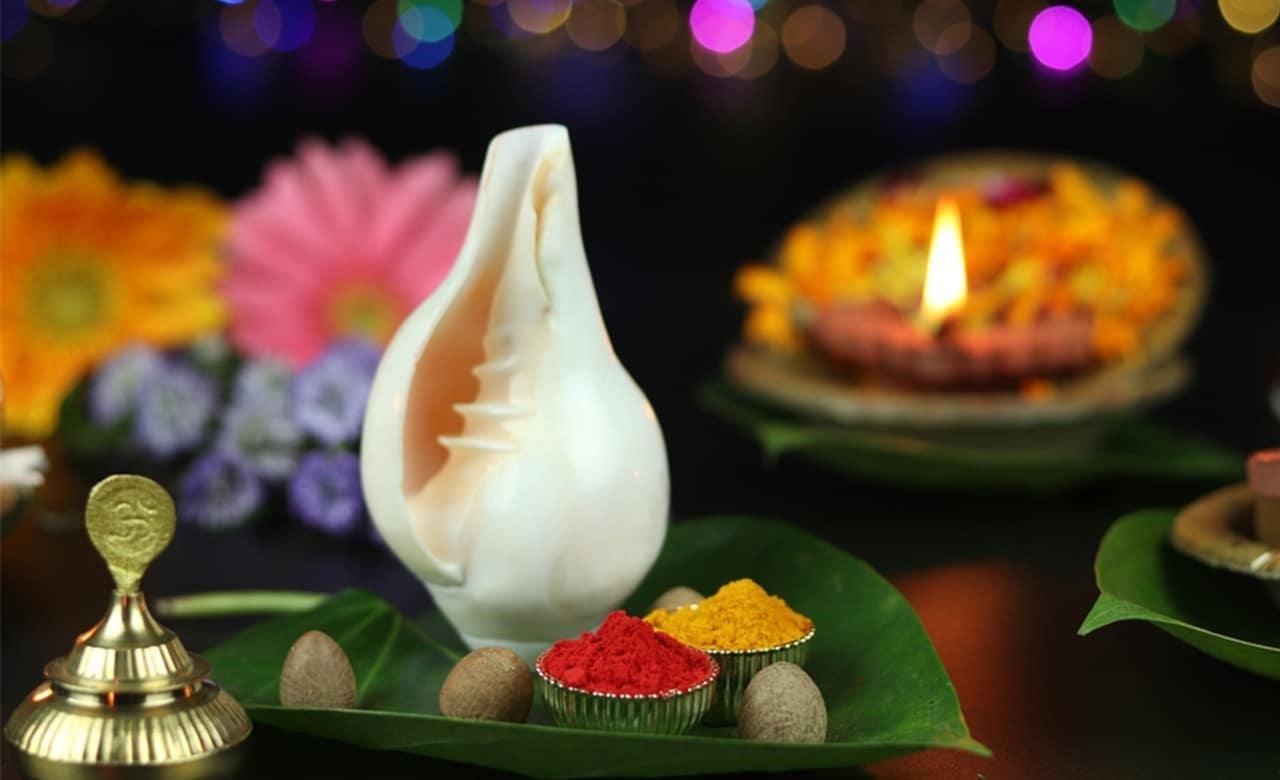
- Keep the Dakshinavarti Shankh on a clean red cloth
- Ideally place it on the right-hand side of the deity
- Never place it near your feet or on the ground
- For Vamavarti Shankh, it can be placed near water vessels or the Kalash
- Position should face East or North-East, similar to Wall Clock Direction as per Vastu
How to Identify the Right-Hand Shankh?
Want to know how to identify right-hand shankh? Here’s how:
- Hold the Shankh with the mouth facing you
- If the spiral opens toward your right hand, it is Dakshinavarti (right-handed)
- It’s rarer and often more expensive
- Always verify the spiral before purchasing
How to Keep Dakshinavarti Shankh at Home?
The Dakshinavarti Shankh demands specific placement and rituals.
- Always keep it in a clean and sacred space
- Do not blow this conch; it’s for worship only
- Offer flowers, incense, and light a diya daily
- Place it on a silver or brass plate facing East/North-East
- Avoid touching it with dirty or wet hands
Knowing how to keep dakshinavarti shankh at home is crucial if you want to truly harness its benefits.
Shankh and Vastu Shastra – What’s the Connection?
Vastu recommends placing auspicious objects like Shankhs to boost cosmic alignment within a home.
- Shankhs placed in the North-East improve spiritual growth
- Combine it with the right Wall Clock Direction as per Vastu to enhance overall harmony
- Ensure the shankh is energized through rituals before bringing it into your pooja room
Rare Types of Shankh – Hidden Treasures
While the most common ones are Dakshinavarti and Vamavarti, here are some rare types of shankh worth knowing:
- Heera Shankh: Extremely rare, diamond-like conch shell
- Moti Shankh: Pearlescent, known for peace and mental calm
- Trilokya Vijaya Shankh: Rarely found, meant for victory over worldly desires
- Valampuri Shankh: Found mainly in Southern India, extremely auspicious and expensive
These rare varieties are often seen in temples or collector homes and are believed to hold immense energy.
Choosing the Right Shankh – Buying Tips
- Check the spiral direction carefully
- Avoid cracks or defects
- Buy only from authentic spiritual shops
- Ensure the seller provides types of shankh with images for comparison
- Choose the conch based on your purpose: wealth, peace, or ritual use
Conclusion
To conclude, the type of Shankh you choose to keep at home can truly influence the spiritual, mental, and even financial energy in your life. From Dakshinavarti for prosperity to Vamavarti for ritual purity, each conch has its own purpose and benefit. The key lies in choosing wisely, placing it as per Vastu, and maintaining it with sanctity.
At Housiey, we believe in holistic well-being — which includes choosing the right home and creating a spiritually rich space. Just like the Shankh adds positivity to your home, we help you find homes that add positivity to your life.
Planning to buy a new home in 2025? Don’t miss our detailed blog on “Auspicious Property Registration Dates 2025” for Vastu-aligned guidance.
FAQs
The melodious echo of a Shankh (conch shell) is deeply rooted in Indian culture, not just for its spiritual significance but also for its impact on home energy and Vastu. It is believed to be the abode of Lord Vishnu, and its sound is said to purify the surroundings, usher in positive energy, and ward off negativity. But here’s the catch — not all types of shankh are ideal for home use. The type, placement, and even direction matter immensely, especially if you’re concerned with Vastu compliance and spiritual harmony.
In this blog, we dive deep into the types of shankh with names, their benefits, the ideal position of shankh in the pooja room, which shankh is not good for home, and much more. Whether you’re an avid believer or a curious learner, this blog will answer all your questions and even introduce rare types of shankh you’ve probably never heard of.
What is a Shankh, and what is Its Historical Significance?

The word Shankh originates from the Sanskrit word Shankha, which means a conch shell. It is considered sacred and is used during religious ceremonies and rituals in Hinduism. Mythologically, it is associated with Lord Vishnu and is said to have emerged from the churning of the ocean (Samudra Manthan).
Over centuries, the Shankh has symbolized prosperity, purity, and divinity. The act of blowing a conch is said to awaken dormant energies and fill the environment with positive vibrations.
Types of Shankh in Hinduism – A Complete Overview
Let’s begin with a detailed overview of all types of shankh, along with their names and significance.
Dakshinavarti Shankh (Right-Handed Conch)

- Spirals to the right
- Associated with Goddess Lakshmi
- Signifies wealth and prosperity
- Ideal for keeping in pooja room
- Not generally used for blowing
Vamavarti Shankh (Left-Handed Conch)

- Spirals to the left
- Commonly used for blowing during rituals
- Associated with Lord Vishnu
- Its sound is said to purify the surroundings
Ganesha Shankh

- Features an embossed figure of Lord Ganesha
- Known to remove obstacles
- Best placed in the pooja room or northeast direction
Kauri Shankh

- A smaller and smoother conch
- Brings prosperity and financial stability
- Often kept in cash boxes or money drawers
Gaumukhi Shankh

- Mouth resembles a cow’s face
- Considered extremely auspicious
- Brings peace and harmony to the household
Heera Shankh (Diamond Conch)

- Extremely rare and valuable
- Known to attract immense wealth and positive energy
- A classic example when referring to rare types of shankh
Moti Shankh (Pearl Conch)

- White and shiny like a pearl
- Enhances calmness, clarity, and peace
- Useful in meditative practices
Pro Tip: When exploring types of shankh with images, make sure to cross-reference with authentic sellers to avoid buying replicas.
Types of Blowing Shankh – For Ritual Use

Blowing shankhs are primarily Vamavarti, but others like Panchajanya (Lord Vishnu’s personal shankh) are also crafted for ceremonial use.
Ideal Types of Blowing Shankh:
- Vamavarti Shankh
- Gomukhi Shankh
- Panchajanya Replica Shankh
These are used in temples and homes to mark the start of prayers or auspicious activities.
Benefits of Keeping Shankh at Home

Let’s understand the benefits of keeping shankh at home from a Vastu and spiritual perspective:
- Purifies the Energy: The sound emitted when blown dispels negative energies
- Invites Wealth: Especially the Dakshinavarti Shankh draws financial abundance
- Improves Focus: Its vibrations enhance meditative states
- Health Benefits: Traditional beliefs suggest it aids in respiratory health
- Creates Positive Aura: Helps maintain harmony and peace at home
Is keeping Shankh at Home Good or Bad?
This is one of the most asked questions: Is keeping shankh at home good or bad?
The answer depends on:
- The type of Shankh (right type = good, wrong one = bad)
- Placement as per Vastu
- Whether it’s used or unused (never bring used temple shankhs)
- Whether it’s blown regularly or left idle
So yes, keeping a shankh at home is beneficial, but only when done the right way.
Which Shankh is Not Good for the Home?
- Damaged or cracked Shankh: Considered inauspicious
- Shankh used in Cremation Ceremonies: Brings negative energy
- Improperly Sourced or Duplicate Dakshinavarti Shankh: This can cause more harm than good
- Black-Colored Shankh: Generally avoided in homes
So if you’re wondering which shankh is not good for home, ensure you don’t pick any of the above.
Position of Shankh in Pooja Room – What’s Ideal?

- Keep the Dakshinavarti Shankh on a clean red cloth
- Ideally place it on the right-hand side of the deity
- Never place it near your feet or on the ground
- For Vamavarti Shankh, it can be placed near water vessels or the Kalash
- Position should face East or North-East, similar to Wall Clock Direction as per Vastu
How to Identify the Right-Hand Shankh?
Want to know how to identify right-hand shankh? Here’s how:
- Hold the Shankh with the mouth facing you
- If the spiral opens toward your right hand, it is Dakshinavarti (right-handed)
- It’s rarer and often more expensive
- Always verify the spiral before purchasing
How to Keep Dakshinavarti Shankh at Home?
The Dakshinavarti Shankh demands specific placement and rituals.
- Always keep it in a clean and sacred space
- Do not blow this conch; it’s for worship only
- Offer flowers, incense, and light a diya daily
- Place it on a silver or brass plate facing East/North-East
- Avoid touching it with dirty or wet hands
Knowing how to keep dakshinavarti shankh at home is crucial if you want to truly harness its benefits.
Shankh and Vastu Shastra – What’s the Connection?
Vastu recommends placing auspicious objects like Shankhs to boost cosmic alignment within a home.
- Shankhs placed in the North-East improve spiritual growth
- Combine it with the right Wall Clock Direction as per Vastu to enhance overall harmony
- Ensure the shankh is energized through rituals before bringing it into your pooja room
Rare Types of Shankh – Hidden Treasures
While the most common ones are Dakshinavarti and Vamavarti, here are some rare types of shankh worth knowing:
- Heera Shankh: Extremely rare, diamond-like conch shell
- Moti Shankh: Pearlescent, known for peace and mental calm
- Trilokya Vijaya Shankh: Rarely found, meant for victory over worldly desires
- Valampuri Shankh: Found mainly in Southern India, extremely auspicious and expensive
These rare varieties are often seen in temples or collector homes and are believed to hold immense energy.
Choosing the Right Shankh – Buying Tips
- Check the spiral direction carefully
- Avoid cracks or defects
- Buy only from authentic spiritual shops
- Ensure the seller provides types of shankh with images for comparison
- Choose the conch based on your purpose: wealth, peace, or ritual use
Conclusion
To conclude, the type of Shankh you choose to keep at home can truly influence the spiritual, mental, and even financial energy in your life. From Dakshinavarti for prosperity to Vamavarti for ritual purity, each conch has its own purpose and benefit. The key lies in choosing wisely, placing it as per Vastu, and maintaining it with sanctity.
At Housiey, we believe in holistic well-being — which includes choosing the right home and creating a spiritually rich space. Just like the Shankh adds positivity to your home, we help you find homes that add positivity to your life.
Planning to buy a new home in 2025? Don’t miss our detailed blog on “Auspicious Property Registration Dates 2025” for Vastu-aligned guidance.
FAQs

















